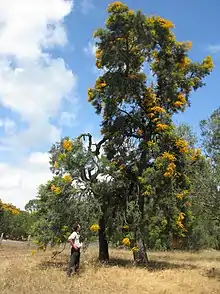David M. Watson
David M. Watson is an Australian ornithologist and ecologist who is also a scientific specialist on mistletoes.[1] He served on the New South Wales Threatened Species Scientific Committee from 2015 until publicly resigning in June 2017 in protest after the NSW Berejiklian government passed a bill granting heritage status to feral horses in the Kosciuszko National Park.[2][3][4][5]
David M. Watson | |
|---|---|
 DM Watson standing next to the hemi-parasitic plant, /Nuytsia floribunda/ in 2007 | |
| Born | Melbourne, Victoria |
| Nationality | Australian |
| Education | The University of Kansas |
| Title | Professor of Ecology |
Education
Watson completed a BSc (Honours) in biology from Monash University in 1994 with a thesis titled "The dynamics of bird communities in remnant buloke (Allocasuarina luehmanni) woodlands". Watson completed a PhD in 1999 at the University of Kansas, with a thesis "Temporal scale and the consequences of habitat fragmentation: Case studies on Mesoamerican highland birds"[6] based on fieldwork centered in Oaxaca, Mexico.
Career
Watson is an ecologist with a research focus on habitat fragmentation and the ecological interactions between plants and birds. He has an interest in the tools of ecological monitoring such as survey methods and acoustic monitoring. He became fascinated with mistletoe during his Honours degree[7][8] and subsequently wrote a global review of mistletoes as a keystone resource in forests and woodlands worldwide.[9] After this publication, he conducted a large removal experiment of mistletoes from woodlands in Australia and showed that mistletoes acted as drivers of bird diversity, especially insectivores.[10][11][12] He wrote Mistletoes of Southern Australia in 2011[13] (2nd ed., 2019)/.[14][15] Currently, his research focus is on the effects of mistletoe on tree health and soils, mostly in farming and production landscapes, including macadamia crops in Queensland,[16] the introduction of mistletoe in urban trees to increase biodiversity within the urban landscape,[17][18] and conservation of sandalwood in Western Australia.[19] Watson developed the 'standardized search' using the Chao estimator equations to easily construct species accumulation curves in the field to ensure that wildlife monitoring between sites is comparable.[20] He was also one of five chief instigators of the Australian Acoustic Observatory.[21]
Watson, in his persona of "Dr Dave" has appeared in three series of educational videos including Dr Dave in Box-Gum Grassy Woodlands,[22][23] Dr Dave in the Murray Catchment[24] and Dr Dave in the Outback[25][26]
Watson is currently a Professor of Ecology at Charles Sturt University in Albury, NSW, Australia.[27]
Personal life
Watson is married with three children.[28]
c
References
- Beemster, Margrit. "Parasitic Plants More Dryad Than Dracula". ScienceAlert. Retrieved 13 February 2020.
- Hannam, Peter (7 June 2018). "'Wilful disregard': Scientist quits NSW panel over wild horses bill". The Sydney Morning Herald. Retrieved 13 February 2020.
- Slezak, Michael (7 June 2018). "Scientific adviser quits over NSW plan to protect brumbies". ABC News. Retrieved 13 February 2020.
- Heathcote, Angela. "David Watson - The impact of wild horses on our national parks". Australian Geographic. Retrieved 13 February 2020.
- Watson, David M. (11 June 2018). "Feral horses are incompatible with a world heritage area. It's one or the other | David M Watson". The Guardian. ISSN 0261-3077. Retrieved 13 February 2020.
- Watson, David M. (1999). Temporal scale and the consequences of habitat fragmentation: Case studies on Mesoamerican highland birds. Lawrence, KS, USA: The University of Kansas. ISBN 978-0-599-64944-6.
- Watson, David (2011). Mistletoes of Southern Australia. Melbourne, Australia: CSIRO. ISBN 978-0-643-10083-1.
- Watson, David M. (1 June 1997). "The Importance of Mistletoe to the White-fronted Honeyeater Phylidonyris albifrons in Western Victoria". Emu - Austral Ornithology. 97 (2): 174–177. doi:10.1071/MU97021. ISSN 0158-4197.
- Watson, David M. (2001). "Mistletoe—A Keystone Resource in Forests and Woodlands Worldwide". Annual Review of Ecology and Systematics. 32 (1): 219–249. doi:10.1146/annurev.ecolsys.32.081501.114024.
- Salleh, Anna (11 July 2012). "Study finds mistletoe key to landscape". www.abc.net.au. Retrieved 13 February 2020.
- Watson, David M.; Herring, Matthew (22 September 2012). "Mistletoe as a keystone resource: an experimental test". Proceedings of the Royal Society B: Biological Sciences. 279 (1743): 3853–3860. doi:10.1098/rspb.2012.0856. PMC 3415901. PMID 22787026.
- Watson, David M. (7 December 2015). "Disproportionate Declines in Ground-Foraging Insectivorous Birds after Mistletoe Removal". PLOS ONE. 10 (12): e0142992. Bibcode:2015PLoSO..1042992W. doi:10.1371/journal.pone.0142992. ISSN 1932-6203. PMC 4671714. PMID 26640895.
- "Mistletoes of Southern Australia". www.newsouthbooks.com.au. Retrieved 13 February 2020.
- PUBLISHING, CSIRO. Mistletoes of Southern Australia.
- "Australian Mistletoes: unwrapping the mysteries of these intriguing native plants". CSIRO PUBLISHING. 2 December 2019. Retrieved 13 February 2020.
- "Macadamias battling mistletoe menace". Good Fruit & Vegetables. 18 April 2019. Retrieved 13 February 2020.
- Gardening Australia. A Sucker for Biodiversity - Mistletoe, Australian Broadcasting Corporation, 20 December 2019, retrieved 13 February 2020
- Making trees better with mistletoe, retrieved 13 February 2020
- CSU Media Release (2019). "Conserving the ecological and economic value of sandalwood in arid Australia". news.csu.edu.au. Archived from the original on 4 April 2019. Retrieved 4 May 2021.
- Watson, David M. (2003). "The 'standardized search': An improved way to conduct bird surveys". Austral Ecology. 28 (5): 515–525. doi:10.1046/j.1442-9993.2003.01308.x. ISSN 1442-9993.
- "Australian Acoustic Observatory | A20". Australian Acoustic Observatory | A20. Retrieved 13 February 2020.
- "What have we got here? With Dr. Dave - Series 1". YouTube. Retrieved 13 February 2020.
- Wirraminna and Petaurus Education Group. "Dr Dave in Box-Gum Grassy Woodlands". www.wirraminna.org.au. Retrieved 13 February 2020.
- Wirraminna and Petaurus Education Group. "Dr Dave in the Murray Catchment". www.wirraminna.org.au. Retrieved 13 February 2020.
- Wirraminna and Petaurus Education Group. "Dr Dave in the Outback". www.wirraminna.org.au. Retrieved 13 February 2020.
- "Dr Dave in the Outback". YouTube. Retrieved 13 February 2020.
- ILWS. "David M Watson". www.csu.edu.au. Retrieved 13 February 2020.
- Tomkins, Rebecca. "A world after human extinction: life forms we should protect and life forms likely to survive". news.csu.edu.au. Retrieved 13 February 2020.
External links
- Official website
- David M. Watson publications indexed by Google Scholar